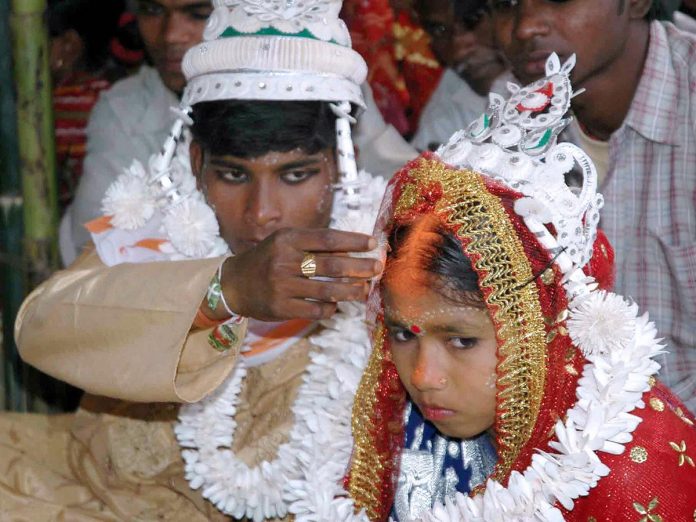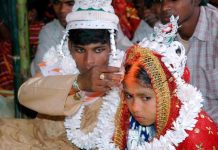This article is written by Ishan Arun Mudbidri from Marathwada Mitra Mandal’s Shankarrao Chavan Law College, Pune. This article talks about Child Marriage Restraint Act and the current child marriage scenario in India.
It has been published by Rachit Garg.
Table of Contents
Introduction
Child marriage in India has been a perennial problem. Girls are the main victims of this practice. Child marriage has a lasting impact on them. They are deprived of their autonomy and face many other issues such as early pregnancies(and health problems arising out of them), illiteracy, social-financial dependence, etc. Hence, to avoid this the Child Marriage Restraint Act was enacted in 1929. This Act laid down the legal marriage age for men (21 years) and women (18 years). This article talks about the legal provisions relating to child marriages in India and also touches upon the recent Amendment Bill introduced by the Indian government to increase the marriage age for women.
History of child marriages in India
Child marriage is the practice where underage kids, i.e., girls below the age of 18 years and boys below the age of 21 years get married with or without their consent(mostly without). This is usually a forced affair where parents, due to some difficulty, get their children married. This practice has been prevalent in India since the pre-colonial era when young women did not have the same status as men and were often considered a burden to the family as a result of which, they were forced to marry.
Lower caste families used to get tempted to marry their daughters to an upper caste boy in return for their own financial and personal gains. Girls marrying at the age of 8 or 9 was common. Another form of marriage that was prevalent during these days was parents fixing their child’s marriage at a future date.
With the advent of the Europeans, the western mindset came into the picture. However the Europeans used this as an agenda to expand their dominance, influencing the minds of the people that it was because of them new changes were taking place. Indian social reformers like Raja Ram Mohan Roy stepped up and defended Indian culture. Due to their contribution, women actively took part in the National Freedom Struggle and helped India gain independence. However, even after attaining independence, these social evils still prevailed on a large scale.
Causes and effects of child marriages
Mentioned below are some of the common causes and consequences of child marriages:
Causes
Poverty
Young girls in rural areas are barred from access to basic resources because their family is poor. Hence they are considered a burden to the family and as a result, forced into child marriages.
Lack of education
High levels of education can make girls aware of the situation and avoid forced child marriages. However a girl is considered a mother and a housewife, so schooling and education get neglected. Even if some families want their girls to learn and educate themselves, they can’t afford those expenses.
Tradition
Tradition is one of the most common cause of child marriages. Parents have a fear of what other families might think if the girl has sex before marriage or if she’s not married as a child. They are also worried that girls might never be able to marry if they are not married at a young age.
Effects
Health complications
Child marriages can lead to early pregnancies, as a result of which the girl is at risk of death or long-term health problems. Moreover, these young girls may not have proper knowledge and awareness of sex education as sex is a taboo topic in India.
Domestic violence
Girls getting married at a young age are more exposed to sexual assault, rape, and, physical and mental torture.
Deprived of their future
Child marriages deprive girls of a bright future and a professional career ahead. They are confined to household work, while the male child is given every opportunity to achieve his dreams.
Age difference
Most child marriages have a huge age gap between spouses. And generally, the girl is the child and not her husband. Hence this makes it easier for the husband to control her, and have a lasting influence on every small thing in her life.
Sex trafficking
Forced child marriages and sex trafficking are considered two separate illegal practices however, as child brides have no say in the marriage and is an exploitation of their rights, it can be considered as a form of sex trafficking.
The Child Marriage Restraint Act, 1929
Can anyone imagine a 5-year old girl getting married! Even thinking something like that might give you goosebumps. Unfortunately, such horrific events have happened. A girl child used to get married off for a number of bad and unnecessary reasons. After getting married, the girl is not educated and is forced to blend into a household that she has absolutely no idea about. She then faces the problem of early pregnancy. Now when she herself is still a child, not educated, and doesn’t even know all the basic values and morals, how can she possibly serve the purpose of being a mother? As sex was more like a recreation in those times, the above-mentioned scenario looks even more likely.
It was the British era in India when the need to end this practice of child marriage was felt the most. But Indians were already dealing with pushing the British away from the country, so pressing for the need to end child marriages seemed like a daunting task. The death of an 11-year-old girl child after getting raped by her adult husband was the trigger. This incident was one of the factors that led to a call for regulating child marriage in India. However, as it was the British who were ruling the country they were more concerned about their personal interests rather than listening to us Indians. Hence despite staunch opposition from the British and after rejecting a number of Bills and memorandums, Rai Sahib Haribilas Sharda introduced his Hindu Child Marriage Bill in 1927. This Bill was referred to a committee known as Joshi Committee in 1929. On the recommendations of this Committee, the Bill was passed by the Imperial Legislative Council of India in 1929. This Act was known as the Child Marriage Restraint Act and also the Sharda Act of 1929. The main feature of this Act was to increase the legal marriage age. For the boys, it was 18 years, while for the girls it was 14 years. Further, the punishment for a male adult above 21 years of age, marrying a minor child was three months of imprisonment and a fine whereas, for a male adult below 21 years the punishment was 15 days and a fine up to Rs. 1000
Later in 1978, an Amendment to this Act was introduced. The Amendment was passed to increase the age of marriage for boys to 21 years and girls to 18 years. This Act was the first social reform in India dealing with the issue of child marriage. Hence this Act looked promising.
Drawbacks of the Child Marriage Restraint Act
As effective as this Act looked in reality, it proved to be a failure. The punishment provisions only extended up to a couple of months and the fine was also minimal. A complaint had to be filed against the offenders to be liable to get punished under this Act.
Further, this Act does not completely abolish the practice of child marriage. The Act nowhere mentions child marriage as void. It only makes child marriage voidable after it is declared so. Till then the practice is valid.
The Act further violates the child rights provisions under Article 21 of the Indian Constitution and also violates Article 16(2) of the Convention on Elimination of Discrimination against Women (CEDAW), which states that a child marriage shall not have legal effect.
Prohibition of Child Marriage Act, 2006
The Child Marriage Restraint Act 1929 was the first of many reforms, however, this Act never really flourished as it was during the British Raj, so no one bothered to create awareness about it. Hence this Act was repealed.
The Supreme Court in 2006, asked the Law Commission to help in certain matters relating to child marriages in India. The main task before the Law Commission was to recommend a single uniform definition of a child so that the legal age can be decided. The Law Commission in its 205th Report in 2008 came up with certain recommendations. Child marriage below 18 years shall be prohibited, below 16 years, the marriage shall be void, and it is mandatory to register the marriage.
The Supreme Court apart from requesting the Law Commission for certain recommendations came up with a new legislation.
Important provisions of this Act
The Prohibition of Child Marriage Act 2006 was an improvement to the 1929 Act and brought certain notable changes. Some of the important features of this Act are as follows:
- Firstly the Act prohibits child marriages in the whole country.
- Section 2(a) of the Act defines a child as a boy who has not completed the age of 21 years, and a girl who has not completed the age of 18 years.
- Section 2(b) states that child marriage is that kind of marriage in which either of the parties is a child.
- Section 3 states that a child marriage shall be voidable at the option of the party who was a child at the time of the marriage.
- The Act further allows for the maintenance and residence of the girl child till she remarries from the male’s side.
- The punishment provisions have been increased. The punishment for child marriage for a boy below 18 years is 2 years jail time and a fine of Rs. 1 lakh.
- The Act also introduces Child Marriage Prohibition officers in the state to prevent such marriages.
- The Act has maintained the principle of gender equality and granted the right to get out of a forced marriage to a male child.
Where to report
The PCA 2006 has introduced the provision to appoint Child Marriage Prohibition Officers by the state government. Such officers have been empowered to provide legal aid and other necessary help to the victims of child marriages. The CMPO also has the power to produce such victims before a Judicial Magistrate of the First Class or before the Child Welfare Committee. The victims can also report to the nearby police station or the child helpline number which is 1098.
Who can file a petition
The petition to end a child marriage can be filed in court only by the girl or the boy, who is below 18 years at the time of marriage. However, a guardian with the help of CMPO can file a petition on behalf of the minor child
Drawbacks of this Act
Apart from increasing the duration of punishment for child marriages, this Act fails to provide much impact. Child marriage is still not void. It is voidable at the option of the child, hence making it a burden for the minor. Many times child marriages are arranged by the parents, so why will they allow the child to go against them and make the marriage voidable?
Further, the 1929 Act required registering a complaint against child marriage and then the punishment shall be imposed. This Act doesn’t differ much. It is necessary to report a case of child marriage to make it voidable.
Further registration of marriage is also not compulsory throughout the country. In the case of Smt. Seema v. Ashwani Kumar (2006), it was held that registration of marriage is important and compulsory registration should be adopted in all parts of the country.
Hence again this Act has its own shortcomings which need to be fulfilled.
Case laws
In the case of Hardev Singh v. Harpreet Kaur & Ors. (2019), the parties to the case had married each other without the consent of their parents. The respondent’s father passed an order under Section 9 of the Prohibition of Child Marriage Act 2006, stating that the appellant was 17 years old as per his school records, but he had stated his age as 23 years. Hence, the Supreme Court observed that the appellant was below the age of 18 years and according to Section 9 of the PCA 2006 if the male is below the age of 21 years and the female is above 18, and they get married, then the male child shall be punished and not the female. The Court also stated that the reason for punishing male adults who contract child marriages is to protect minor female children.
In the case of Nargis & Anr, v. State of Punjab & Ors, (2021), a Muslim girl aged 17 years had married a Hindu who was 33 years old, against the wishes of their families. The couple felt threatened by their families and thus filed a writ petition under Article 226 of the Constitution. The Court stated that as the girl was Muslim, her marriage shall be governed by the Muslim Personal Laws. The book “Principles of Mohammedan Law”, states that a girl who is 17 years old is a major and hence can marry the person of her choice. Hence a minor’s marriage is invalid under Muslim Law but in this case, the girl was a major so the marriage shall be valid.
Is raising the age of marriage for women the only solution to end child marriages
Prohibition of Child Marriage Amendment Bill, 2021
After 15 years, a provision was introduced to amend the PCA 2006. Seeing the rise in child marriage cases despite the PCA, the government decided to amend certain provisions of the Act.
A 10-member NITI AAYOG task force put forth certain recommendations to look into the legal age of marriage on key parameters like infant mortality ratio, child sex ratio, fertility ratio of children, etc.
Owing to this, the Prohibition of Child Marriage Amendment Bill was 2021 was introduced. Key features of this Amendment Bill are:-
- The definition of a child has been changed to a male or female who has not completed 21 years of age.
- The duration for filing a petition for declaring child marriage invalid has been increased from two years to five years.
- The Bill further states that the existing enactments like the Indian Christian Marriage Act, 1872, the Parsi Marriage and Divorce Act, 1936, the Muslim Personal Law (Shariat) Application Act, 1937, the Special Marriage Act, 1954, the Hindu Marriage Act, 1955, and the Foreign Marriage Act, 1969, despite talking about the age of marriage, do not provide for a uniform age.
Hence this Bill seeks to promote gender equality and aims at reducing miscarriages, early pregnancies, etc.
Critical analysis of this Bill
The recently introduced Amendment Bill on child marriage in India if enacted, shall apply to all communities and also amend the existing enactments which I mentioned above. However, this Bill had to be referred to a Parliamentary Standing Committee due to major criticism. Many pointed out that before this, for 15 years the legal age of marriage for a girl child was 18 years and there was still a huge rise in child marriage cases. So is increasing the age by 3 years, going to drastically reduce such incidents? Some pointed out that, in a country where after turning 18, a girl can vote, is considered an adult, can enter into sexual intercourse, but cannot marry? Experts observed that increasing the age for marriage might increase criminal cases against women.
The present scenario
The recent Amendment Bill was introduced a few months back in 2021, seeing the rise in child marriage cases even during the COVID-19 lockdown. So let me show you the state-wise number of child marriage cases in India in 2020, compiled by the National Crime Records Bureau (NCRB) and the Women and Child Department.
| STATE | NUMBER OF CASES |
| MAHARASHTRA | 130-140 |
| KARNATAKA | 184 |
| ASSAM | 138 |
| WEST BENGAL | 98 |
| TAMIL NADU | 77 |
| TELANGANA | 62 |
A total of 785 cases were registered last year, which was topped by Karnataka State. Now one may argue that the bigger the State, the larger the population, and the greater the divide between rural and urban areas. So more cases are bound to be from rural areas, right? This argument is absolutely false. Yes, it’s true that there are cases from the rural areas, but if you look at the city-wise distribution of cases in Karnataka, Mysore, and Belgaum which are two major cities in the State, have contributed to around 60-70% of the cases.
Age is just a number
The recently introduced Bill on Child marriage in India is very women-centric and aims at gender equality. In a National Family Health Survey of 2005-06, it was seen that 45% of women, mostly from rural areas, were married before the age of 18 years. This number might be seen as an old one, but that’s not the point. Will increasing the age to 21 years reduce something which has been on the rise since 15 years when the age was 18? The gender-equality argument is fair and true, but increasing the age might not stop women from marrying early due to family issues and social stigma. Further, the existing provisions are not that stringent to avoid child marriage cases. They nowhere mention that child marriage is void. Even this proposed Bill doesn’t mention it. Moreover, a report has to be filed to register a case of child marriage. Thousands of COVID-19 positive cases have gone unnoticed, so why will people bother to report a case of child marriage.
Girls don’t drop out of schools or colleges due to marriage, it is because of family pressures and other social issues. Hence accessible education throughout the country should be provided to each and every girl. In the years 2019-20 according to the Ministry of Education, the Gross Enrollment Ratio in Education has increased by 27%, as compared to 2001. Hence there is a willingness among girls to study and empower themselves. So will increasing the age of 21 years have an impact on this?
Women’s groups such as the All India Democratic Women’s Association mentioned that the political establishment must look at improving women’s empowerment, rather than increasing the marriage age. Hence there is a need to improve the existing reforms on child marriage, make them more stringent and effective to protect women.
Conclusion
The Supreme Court in the case of Independent Thought v. Union of India (2017), had held that a man committing sexual intercourse with his wife who is less than 18 years of age, will amount to rape under Section 375 of the Indian Penal Code, 1860. This judgment proved to be a landmark one in terms of child marriage and girl brides. Hence as the government is trying to improve the child marriage scenario, stringent reforms of this sort are the need of the hour.
References
- https://legislative.gov.in/sites/default/files/A2007-06.pdf
- https://wcd.nic.in/child-marriage-restraint-act-1929-19-1929#:~:text=An%20Act%20to%20restrain%20the%20solemnisation%20of%20child%20marriage.&text=(1)%20This%20Act%20may%20be,India%20without%20and%20beyond%20India.
- https://www.icrw.org/files/images/Causes-Consequences-and%20Solutions-to-Forced-Child-Marriage-Anju-Malhotra-7-15-2010.pdf
Students of Lawsikho courses regularly produce writing assignments and work on practical exercises as a part of their coursework and develop themselves in real-life practical skills.
LawSikho has created a telegram group for exchanging legal knowledge, referrals, and various opportunities. You can click on this link and join:
Follow us on Instagram and subscribe to our YouTube channel for more amazing legal content.
 Serato DJ Crack 2025Serato DJ PRO Crack
Serato DJ Crack 2025Serato DJ PRO Crack











 Allow notifications
Allow notifications



